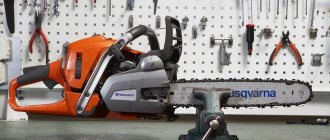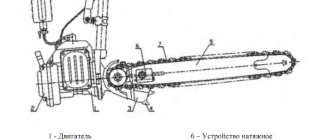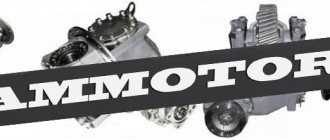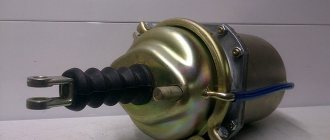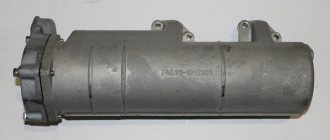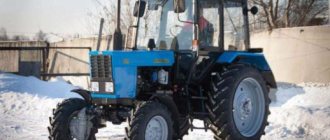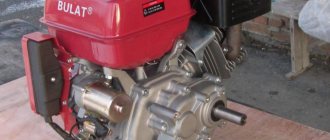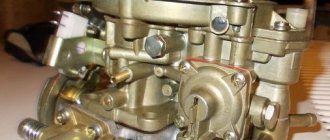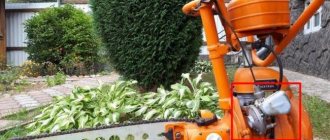The need for underwater mining arose a long time ago due to the need to maintain the proper depth of shipping routes. These works were initially carried out manually using simple devices and, due to unenviable productivity, were limited to only a small area near the quay walls.
The first swallow is a floating dredger.
Mechanized soil sampling from the bottom of a reservoir (underwater soil sampling) originated in the 18th century and was carried out by scooping. The first multi-scoop floating projectile was invented by Savery in Holland in 1718. However, such a machine was built only in 1747 in England. Then the name was assigned to it - dredger. The first car had a manual drive. A similar dredge was built in 1760 in France. Structurally, the first dredges had a vertical fixed frame that went into a well (Fig. 1-1), made in the middle of the scaffold.
In 1781, the first horse-powered dredgers appeared in England. Only in 1796, according to the design of James Watt, the first dredge with a steam engine was built. The productivity of multi-scoop machines grew quite quickly and reached 150-170 m3/h. However, all the shells had one common design flaw: the lower drum of the scoop chain was located under the body. Such shells could only be fired from underwater shallows. But already in the 40s of the 19th century on the river. Garonne in France operated the first multi-scoop machine, its layout was quite close to modern ones, in which the lower drum of the scoop chain was placed in front of the body. A wooden inclined scoop frame was placed in a slot made along one of the sides. The projectile's steam engine had a power of 18 hp. With. The dredge's productivity was about 10 m3/h.
The first dredger in the world.
Dredgers came into service with dredgers much later than dredgers. Only in the 19th century did projectiles appear that carried out soil collection by sucking up a water-soil mixture. Underwater soil suction was first used in France in 1859 for dredging work in the port of Saint-Nazaire, where a suction dredger with a piston pump was used.
About 5 years later, suction dredgers with centrifugal pumps appeared in France and almost simultaneously in England, which very quickly completely replaced piston pumps.
In 1867, Bazin built the first suction dredger in the Old World with a mechanical soil loosener. This projectile, with a development depth of up to 12 m, had a productivity of up to 3,000 m3 of sand per day, which was a huge amount for that time. Such vessels are called Bazin devices. In 1888 prof. V. E. Timonov proposed calling such machines dredgers, by analogy with dredgers.
The first amphibious dredger.
A dredger capable of going from water to land and back was first built in the United States by Oliver Evans in Philadelphia in 1804. In addition, the dredger was the first self-propelled one, since it could move through the water due to the blades of the wheel located at the stern. This vessel was also a pioneer among dredgers equipped with a mechanical ripper. The work was carried out on the Delaware River. The vessel was based on a flat-bottomed scow, the soil intake device was equipped with buckets on a chain, and in order to be able to remove more significant objects it had a kind of lifting device. The energy for the dredger was produced by a high-pressure engine. The dredger was almost 9 meters long, 3.6 meters wide and weighed about 17 tons.
What about in Russia?
The first suction dredgers in Russia, brought from Europe, appeared in 1874. Volga. These were projectiles with centrifugal pumps and free suction without disintegrants. The productivity of these shells was 30 m3/h on the ground, which was clearly not enough to clear the Volga rifts. In 1893, the first suction dredger with a mechanical ripper appeared on the Volga. This projectile was built in the workshops of the Kazan Railway District in the Vasilevo backwater. In 1897, on the initiative of the largest Russian hydraulic engineer V.E. Timonov, the Russian government ordered from England the most powerful suction dredger at that time. The total installed power of all steam engines, generators and electric motors on this projectile was about 9,000 hp. With. or 6,600 kW (project of Lyndon and V. Bethea). We can say that this vessel was the first truly modular dredger, since it consisted of two separate sections. The sections were supposed to be carried through the Mariinsky system locks and then connected together. However, this was not carried out and both halves worked as independent projectiles for more than 40 years. The Sormovo plant built the first river dredge in 1900. Other Russian factories (Baltiysky, Lutilovsky) also began to build them. The impetus for the development of domestic land construction was the large-scale work that began in 1909 to wash out the Bibi-Heybat Bay near Baku. The Sormovo Plant Society took over the implementation of this work, with a volume of 15 million m3 of soil, and for this purpose it built four suction dredgers with floating slurry lines with a diameter of 650 mm. Before the revolution, the Russian river dredging fleet mainly consisted of low-cost dredges manufactured by foreign companies. By 1917, the Russian dredging fleet included about 20 suction dredgers and 100 multi-scoop dredgers. Dredging technology in Russia received significant development only after the Great October Revolution, when the country found itself isolated and had to follow the path of import substitution. This is how powerful multi-scoop shells were built, which were not inferior in their operational and economic indicators to the best shells of this type produced at that time in Europe.
The first electric dredger.
The first electric suction dredger for construction and mining work in the USSR was designed and built in 1937-1938. on the initiative and under the leadership of B. M. Shkundin. This suction dredger was equipped with a ZGM-1 soil pump and had a soil capacity of 100 m3/h. Then nine such shells were manufactured at the Dmitrov Mechanical Repair Plant; they successfully worked on the construction of the South Harbor in Moscow and on the construction of other facilities. The creation of these suction dredgers marked the beginning of the widespread introduction of suction dredging into hydraulic engineering construction. So, if during the construction of the Moscow Canal (1932-1937) more than 97% of all hydromechanized earthworks were carried out with hydraulic monitors, then already during the construction of the Volga-Don Canal named after V.I. Lenin (1948-1951) hydromonitors were carried out only 2.5% of the named work, the remaining 97.5% - with electric suction dredgers.
What happened next?
From 1938 until 1973 under the leadership of B. M. Shkundin, a series of suction dredgers with increasing productivity were created, intended for hydraulic engineering construction. Thus, for the construction of the Kuibyshev hydroelectric complex (to develop a foundation pit for a concrete dam), electric suction dredgers with a capacity of 300 m3/h of soil were designed and built. Previously, it was planned to carry out this development using the hydromonitor method, while the installed capacity of pumping and dredging stations would have been 25 thousand kW. In addition, deep drainage required by this method required large amounts of power. The transition to suction dredgers made it possible to reduce the total installed power for excavation work to 15 thousand kW, i.e. 1.6 times. The first two shells with a capacity of 300 m3/h of soil were tested in 1940. During the years of construction of the Tsimlyansky hydroelectric complex and the Volga-Don Canal named after V.I. Lenin created suction dredgers with a capacity of 500 m3/h of soil.
In connection with the start of construction of the largest hydroelectric complexes on the Volga, the need arose to create even more powerful equipment. In 1950, the Volgograd Shipyard built nine shells with a capacity of up to 1,000 m3/h of soil, known under the brand name 1000-80.
Thus, hydraulic builders were armed with a series of large electric suction dredgers with a capacity of 300, 500 and 1,000 m3/h of soil. So, according to statistical data, as of the end of 1972, about 2 billion m3 of earthworks were completed with such shells.
What if it's stronger?
Since 1958, the All-Union Order of Lenin Design, Survey and Research Institute "Gidroproekt" named after S. Ya. Zhuk has been designing special projectiles. Special projectiles primarily include milling equipment for the development of heavy cohesive clay soils and rocks.
In 1970, Hydroproekt, taking into account the operating experience of projectiles of the 350-50T type, released a working draft of a modernized projectile for the development of heavy soils. Also, according to the drawings developed by Gidroproekt, a prototype of a suction dredger was built to develop soils at a depth of up to 45 m. In 1969, this projectile successfully passed production tests.
Russian drag construction.
The development of gravel and boulder deposits is often carried out using specialized dredges. Multi-scoop shells on which processing equipment is mounted are called dredges. In Russia, dredges were first used in Siberia in 1893 on the river. Kudeche and in 1898 on the river. Urusha. In the Urals, the first dredges appeared in 1901 on the river. Is. All dredges worked for gold mining. Dredges were built at the Nevyansk and then at the Putilov plants. The famous Russian professor E.N. Barbot de Maria took a large part in improving the design and mastering the first domestic dredges. After the Great October Revolution, the dredging business began to develop rapidly. Beginning in 1929, the Irkutsk Heavy Engineering Plant (IZTM) named after V.V. Kuibyshev began building dredges with 150-liter scoops. After the Great Patriotic War, this plant produced dredges with 210 liter scoops, and then 250 and 300 liters. In the 70s, this plant produced a unique dredge with 600 liter scoops and a digging depth of up to 60 m.
In the early 80s. The most widely used in the USSR and abroad are electric and diesel-electric multi-bucket dredges with a rigid frame and scoops with a capacity of 50-700 liters (Fig. 2), operated on coastal-sea and continental placers of gold, platinum, tin, rare metals and diamonds with depth up to 50 m below water level. Models of domestic dredges: 80D, 150D, 250D, 600D, OM-431, etc. (nominal capacity of scoops 80-600 l). The average hourly productivity of dredges is 100-550 m3.
A dredger is a vessel used to excavate soil under water. In this case, the hydromechanization method is used, which is the pumping of certain liquids containing soil particles (or pulp) with a special pump. The liquid flows through the slurry pipeline over quite significant distances.
Information about the operating principle and design of this equipment was provided by Gidromekhanizatsiya CJSC.
How does a dredger work?
The principle of operation and design of the dredger are a complex system where the main working body is the soil pump
– a pumping device with high resistance to abrasive in the flow part.
As a rule, soil pumps are located in the hold of the ship. This is necessary so that the axis of the pump itself can be lowered below the water level. This technique prevents the occurrence of cavitation, which significantly reduces the time of normal operation of the pump.
Using a soil pump, soil particles combined with water are sucked from the bottom. Next, the installation pumps the particles through pipes to the shore or to a scow, also called a soil barge.
In addition, the dredgers are equipped with pumps for technical water supply
. The main ones are hydraulic loosening and ejection pumps.
Hydraulic loosening is necessary when excavating in non-cohesive soils. This type of soil includes sand-gravel mixtures and sand. A jet of water, supplied under high pressure, crashes into the bottom of the reservoir. In this case, suspended particles from pulp and water appear. By means of an ejection pump, water is supplied to the suction pipe inside the soil pump. This process reduces the force required to suck up the mixture from a great depth. Thanks to the operation of pumps for technical water supply, the efficiency of the main pump increases. This is important for completing work whose deadlines are limited.
Movement of equipment
For a suction dredger to work properly, it needs to move along the water surface. Movement on water is possible using winches
or a special
pile move
. There are vessels in which the design and principle of operation of the dredger combine the two above options.
Soil movement
An equally important element of dredgers can be called the pipeline
, which serves to transport pulp. Some time before the start of work, parameters are calculated that include the total length of the pipeline, the diameter of all pipes, the details of the installation of the pipeline and its use. Hydrostatic pressure is created in the pipes during operation. It may be too large for the main pump. Therefore, it is necessary to perform hydraulic engineering calculations for all working elements of the dredger.
History of the device
The first dredgers appeared in Italy at the end of the 16th century to clean Venetian canals. They were dredgers with a manually operated double-leaf grab. A big leap in the development of this industry occurred with the beginning of the production of steam-powered machines.
In the middle of the 19th century, dredgers appeared that engaged in dredging by suctioning pulp. And in 1878, in Holland, for the first time, a suction dredger was mounted on a sea vessel. Through a special tube, the soil was sucked in and flowed into the hold.
In Russia, such equipment was developed at the Izhora plant in 1811. Since then, the operating principle of the dredger has not changed much.
Control
In the vessel, the dredger operation process itself is controlled directly from the baggermeister cabin. The control panel includes many devices and sensors. The bagger's remote control controls all existing systems: from starting the dredger to turning on a light bulb in the engine compartment.
Dredging units
are intended for sucking up soil from the bottom of a reservoir (sometimes with preliminary loosening) and moving it along a slurry pipeline to the laying site or for transporting soil from the development site to the laying site. They are used in the construction of canals, deepening and cleaning of canals, sedimentation tanks, rivers, lakes, seas, and reservoirs; for extracting building materials from under water (sand, gravel); for reclamation of dams and dams.
The development of soil by a suction dredger is based on the erosive and dragging ability of water. Centrifugal pump 3 (Fig. 178) creates a flow of water that separates soil particles from the bottom of the reservoir. Through the soil receiver 1, it is carried into the suction pipeline 2, fills the pump housing and is thrown out by the impeller into the discharge and transport pipelines 5 and 6, through which it is transported to the installation site. The transport pipeline (slurry pipeline) 6 within the reservoir is laid on pontoons 7. The centrifugal pump is driven by engine 4.
Continuous soil suction is ensured by the constant location of the soil receiver in close proximity to the developed soil. To do this, the soil receiver is moved across and along the layer being removed and the angle of inclination of the suction pipeline in the vertical plane is changed. Piles 8 for controlling the movement of the dredging unit are lifted by winches.
When developing cohesive soils, a mechanical ripper 9 is installed at the soil receiver, which separates soil particles from the mass with knives, and the water flow created by a centrifugal pump captures them and sucks them in suspension into the suction pipeline. A centrifugal pump installed on dredging units is called a dredger.
Rice. 178. Scheme of operation of the dredging unit
: 1 — soil receiver;
2 - suction pipeline; 3
- centrifugal pump;
4
- engine;
5
- discharge pipeline;
6
- transport pipeline;
7 — pontoons; 8
- piles;
9
- mechanical ripper.
The dredge pump (Fig. 179) differs from conventional water centrifugal pumps only in that the body 1 and impeller 2 are designed to pass water with soil containing large rocky inclusions and are made of wear-resistant materials. The impeller (one-way suction) is mounted cantilever on shaft 3, supported by bearing support 4 and connected directly to the electric motor shaft by an elastic coupling, or through a gearbox and friction
Rice. 179. Dredger
: 1 - body; 2 - impeller; 3 - shaft; 4 — support; 5 - pressure pipe; 6 - suction pipe.
clutch with an internal combustion engine. The shaft with the impeller is held against axial displacement by a thrust bearing installed at the rear of the bearing support. The impeller hub is located in a stuffing box, which protects it from contact with abrasive particles. To protect the stuffing box seal from slurry, clean water is supplied under pressure between the housing and the impeller on the shaft side. Cleaning and checking the condition of the housing and impeller is carried out through hatches in the housing. Suction pipe 6
attached to the front cover. To suck out air when starting the dredger, there is a hole in the upper part of the body to which a vacuum pump is connected.
The impeller has 3 to 6 blades spiraling from the center to the outer diameter between two end discs. When the impeller rotates, a vacuum is formed at the suction pipe, and the pulp is sucked into the space between the blades, from where it is pushed into the pressure pipe 5
dredger and further into the pipeline.
Dredging units are divided into land-based and floating. Land installations are manufactured: stationary and mobile on railway, tracked, walking and wheeled; floating - on pontoons.
Stationary dredging units are used for volumes of work that can be performed from one parking lot, and for transporting soil developed by other machines.
Mobile dredging units are used for work when, due to terrain conditions and the volume of work, soil development or transportation from one parking lot cannot be ensured and the unit must be moved towards the face.
Dredging installations intended only for transporting soil are made with a stationary suction part during operation.
In irrigation and drainage work, floating suction suction units - dredgers - are most commonly used. Based on their design, they can be divided into two groups: - dredgers for reclamation and dredging work, adapted for work on canals, rivers, lakes and ports. These dredgers have their own diesel or diesel-electric power plant and are adapted to work in fast water flows and large waves;
Dredgers for construction purposes and mining with mechanisms driven by electric motors powered by electricity from a stationary or mobile power station. These installations are used in the construction of large canals, pits, cleaning of settling basins and canal heads, reclamation of dams and dams, for the extraction of sand and gravel from under water and in stripping operations.
Diesel and diesel-electric small-sized dredgers are used to clear sediment from canals, ponds, reservoirs, dredge the bottom of small rivers, supply channels of pumping stations, build irrigation and drainage canals, dig pits for reclamation structures and other similar work. They can be divided into dredgers for working on canals and in excavations with a bottom width of over 2.5 m with a capacity of 20-35 m3/h and over 5 m with a capacity of 60-100 m3/h.
Dredgers of the first group (Fig. 180) are manufactured with a combined device for developing and transporting soil. Housing 3 is metal, flat-bottomed, with rectangular contours. In machine room 6, a dredger and a generator are installed in the front part, and an internal combustion engine is installed in the rear part.
Rice. 180. Small-sized floating dredger
: 1-rotor ripper; 2 - mixing hopper; 3 - body; 4 - rope; 5 — control panel; 6 — engine room; 7 - piles; 8 - canopy; 9 — winch; 10 - bracket.
The working bodies - rotary ripper 1 and the suction pipe passing through the mixing hopper 2 - are pivotally connected to the body and suspended on a pulley block to the bracket 10 so that they can be raised and lowered with a winch. The control panel 5 with control devices is located on the deck in the bow of the hull, covered on top by a removable canopy 8. The projectile performs its working movements using piles 7 and two ropes 4, attached to a papillon winch 9.
Most small-sized dredgers have replaceable working equipment - a sucker, a scooping device and a rotary ripper. Sucker is used to develop sands and loose sandy loams; with a scoop device - dense sandy loams, light loams; rotary ripper - viscous silty soils overgrown with vegetation. It takes 1.5-2 hours to replace working equipment.
Dredgers of the second group (Fig. 181) are manufactured with a non-dismountable body 10 and a body 10 that can be dismounted into two parts. The working parts - milling ripper 1 and suction pipe - are mounted on a frame 11, which is pivotally connected to the body 10 by the fifth, and the head is suspended on a pulley. The ripper is rotated by a motor 12 installed on the platform at the heel of the frame. Papillon winches 2 are located on the bow deck, and pile lifting winches 7 are located on the rear deck of the hull. Dredger 3, priming pump 4, internal combustion engine 5 and diesel generator b are located in the hold of the machine room. The piles are attached to the rear of the body by 8 guide brackets. The floating slurry line 9 is connected to the discharge pipe of the dredger using a flexible hose or a ball joint.
Electric dredgers
(Fig. 182), intended for the mechanization of excavation work at large hydraulic facilities and stripping operations, as well as for the extraction of building materials, are produced with a capacity of 100, 300, 500 and 1000 m3/h, weighing from 64 to 650 tons. They have essentially the same the same design as small-sized diesel-electric projectiles, but they do not have their own source of electricity (diesel generator).
Rice. 181. Dredger with diesel-electric drive:
1 - milling ripper - 2 - papillon winch; 5 - dredger; 4 - filling pump; 5 - internal combustion engine; 6 — diesel generator; 7 — winch for lifting piles; 8 — pile apparatus; 9 - pulp conduit; 10 - body; 11 - frame; 12 — ripper drive electric motor.
Rice.
182. Dredger with electric drive: 1 - cutter; 2 — rope to the anchor; 3 - frame: 4 - body; 5 above-deck superstructure; 6 - dredger; 7 - electric motor; 8- piles; 9 — winches; 10 - floating slurry line.
The body 4 of the dredger is divided into water-permeable compartments. The above-deck superstructure 5 is equipped with papillon winches and a control panel. The dredger 6, connected by an elastic coupling to the electric motor 7, a centrifugal pump for filling the dredger and supplying water to its seal, and a vacuum pump are located in the middle compartment of the hull hold. Piles 8 are lifted by winches 9 located on the deck of the rear part of the hull. The floating slurry line 10 is connected to the pressure pipe of the dredger by a ball joint. The frame 3 of the ripper is attached on two hinges in the cutout of the body and suspended on a chain hoist. Ropes 2 from the papillon winches to the anchors go through guide blocks mounted on the ripper frame. Ripper 1 is driven into rotation by an electric motor through a gearbox. The electrical devices of modern dredgers are very complex and consist of a high-voltage flexible power cable for connection to coastal networks (usually laid along the pontoons of a floating slurry line), starting and protective equipment, a transformer substation, a high-voltage and low-voltage internal network, a blocking and secondary switching system and a centralized control panel . Electrically driven dredgers use milling, rotary
Rice. 183. Papillonage scheme for a conventional pile move:
/, // - winches;
1-4
- soil layers.
Rice. 184. Papillonage scheme for rotary pile driving
:
1-III
- dredger position;
1,2 -
ropes.
and hydraulic rippers. The last two species are almost not widespread. For the working movements of dredgers, two types of pile passes are used: two piles, each of which is attached in guides to the dredger body (see Fig. 180), and two piles passing in the guides of the rotary cage (rotary pile drive) installed at the rear of the body, so that it can rotate about a vertical axis (pressure rotary pile drive).
With the first type of pile drive, the movement of the dredger during soil development is performed by alternately turning the projectile around one of the piles (Fig. 183). Pile A
under the influence of its own weight it sinks and sinks into the ground.
Winding the cable around the winch / and loosening the winch cable //, turn the projectile around pile A
to the position shown in the dotted line.
At the same time, the working body removes a layer of soil /. Then Pile A
is raised and Pile
B
is lowered.
Winding the cable onto the winch // and loosening the winch cable /, turn the projectile around pile B,
2
of soil . By repeating such operations, layers are removed until the anchors need to be repositioned. Having moved the anchors to a new place, further development is carried out in the same way.
With such a pile drive, the dredger, making working movements, rotates relative to different axes. Due to this, the working body passes part of the way along the mined-out section, and leaves part of the section undeveloped. When developing heavy cohesive soils, this disadvantage reduces productivity.
The rotary pile drive ensures the excavation of soil in regular concentric strips with slight overlap (Fig. 184) due to the fact that the pile on which the rotation occurs is each time fixed to the axis of the slot. To start work, the dredger is set to position /. A pile is fixed into the ground, installed with a guide clip along the axis of the projectile body. Winding the rope / onto the winch drum and loosening the rope 2
the dredger rotates around the lowered pile to position //.
Then, using a special mechanism, the guide holder with piles rotates until the raised pile moves forward and aligns with the axis of the slot. Simultaneously with the rotation of the raised pile, the same mechanism moves the dredger forward to the /// position. By tensioning rope 2
with the rope weakened, the dredger rotates relative to the newly lowered pile and removes the next strip of soil. So, by turning the dredger relative to the piles lowered one after another and moving forward, the soil is removed before repositioning the anchors.
The pulp from the dredger to the shore is pumped through a floating pipeline - a slurry line, and then through pipes laid on the ground or special supports.
A floating slurry pipeline is a chain of pontoons (barrels), hingedly connected to each other, with pipes laid along them. Some pontoons are equipped with hand winches, with the help of which the slurry line is secured with anchors from being displaced by water flow and wind.
To transfer anchors within a reservoir, a boat or boat is attached to the dredgers, and floating cranes are used to connect the floating slurry pipeline to the shore one.
Float level gauges are installed on tanks for storing liquid and bulk substances.
Any lake of artificial or natural origin performs its functions and can be successfully used for swimming, watering or growing fish. And no one has yet canceled aesthetic pleasure. The reservoir functions normally as long as the water filling it remains clean. If it is polluted, then in hot weather it becomes a beneficial environment for harmful fungi, bacteria and algae.
After this, rest near such a body of water becomes impossible due to the bad smell and the presence of flying insects. And the pond turns into a headache for its owner. To prevent this from happening, it is necessary to timely monitor the condition of the reservoir and clean it of silt and other mechanical contaminants in the form of fallen leaves and debris. How often should this be done? Small ponds and lakes located on personal plots are recommended to be cleaned once every three to five years.
The larger the volume of the reservoir, the faster it restores itself
Financial costs for organizing the sand extraction process
The following figures will be given that are averages and cannot accurately reflect the real situation, especially since it will vary from region to region. And in an unstable economy, average price data often changes. But they can show the approximate amount of investment and effort that will be needed when planning a business.
- The first thing that any sand mining activity cannot do without is an excavator. If you are starting from scratch, then you also need to take care of purchasing an excavator in advance. There are also a lot of companies selling special equipment on the market, so you will need to spend some time in order to obtain all the necessary information. As an entrepreneur, you need to understand what characteristics your machine should have and what brands of manufacturers are suitable for your business. Well, then the matter remains small. Analyze the prices of suppliers of foreign cars and choose the best offer.
As an option, we can recommend an excavator from the Korean manufacturer Hyndai, namely the R220LC-9S model. The bucket volume of this machine is 1.43 m3, the digging depth is 6.440 mm.
Buying an excavator will cost from 1.5 million rubles.
- Next in importance is the front loader. Just as in the case of an excavator, it is worth adequately assessing your needs and offers on the market. But you will have to pledge no less than the first point. The cost of a new loader with sufficient characteristics starts at around one and a half million rubles.
- Machine with dump truck function. (As an option, you can consider the KrAZ 6510 model with a lifting capacity of up to eighteen tons and the required platform volume). Prices for dump trucks start from 2.3 million rubles.
- Insulated cabin trailer. From 350,000 rubles.
Next come small household expenses (compared to the previous points):
- Communication means for workers (walkie-talkies) 30 – 50 thousand rubles
- Fire shield. 10 thousand rubles
- Fuel tanks. The volume should be 200 liters. From 25 thousand rubles.
- Oil tank. 200 liters. From 8 thousand rubles.
- Heater. From 3 thousand rubles.
- Gas stove. From 7 thousand rubles.
- Gas cylinder for refilling. From 3 thousand rubles.
- Drinking tank. From 5 thousand rubles.
- Electricity generator for a diesel trailer. From 350 thousand rubles.
- Inventory for a change room (tables, chairs, refrigerator) – from 12 thousand rubles.
The total capital costs for the purchase of everything necessary to start work amount to about 10 million rubles.
Methods for cleaning water bodies
There are several common techniques. If possible, you can pump out the water and remove everything manually or using special equipment (excavators, tractors, etc.). But the owners of private ponds and lakes do not want to carry out such large-scale work. Then a mini-dredger comes to their aid, which copes well with such functions. You can purchase this equipment for personal use or rent it, since now a large number of companies provide such services.
What can you do with a mini dredger?
The advantage of this equipment is that it can be easily used in reservoirs where access to large equipment is impossible. Due to its small dimensions and good performance, it can be used on ponds and lakes of up to several hectares or on rivers for work in a specific area.
With its help you can perform the following actions:
- restore abandoned beaches and create new swimming areas;
- deepen and clean small lakes, ponds, rivers and canals;
- wash away the reeds and build dams with embankments.
It is impossible to completely remove aquatic vegetation with a dredge, as, in principle, it is impossible to use industrial equipment, but it is quite possible to erode the soil where the root system is located. After this, you just need to collect all the algae mechanically or manually.
Advantages of purchasing from us:
- Experience: we are the manufacturer of this equipment. For 20 years we have been manufacturing dredgers.
- Wide range: we offer dredgers of various performance and power.
- Supervision of installation: we offer supervision of installation of equipment supplied by us.
- Delivery: we deliver equipment throughout Russia and the CIS.
- Sale of auxiliary equipment for dredgers.
- Service support for supplied equipment, availability of spare parts and components.
- Providing consultations, prompt processing of applications.
Operating principle of mini dredger
The float serves as a platform where all the equipment is located. The mechanism for collecting soil with a loosening agent is equipped with blades of various types. They have special holes through which air enters and mixes with the raised soil. After this, the soil pump takes silt and sand through a slurry pipeline and delivers them to the required location.
All manipulations of this equipment are carried out from a floating platform
Depending on the type and manufacturer, there are a large number of varieties of mini-dredgers. Three types of this equipment are most popular in Russia.
Mini dredger "Crab"
This is a very compact model that is small in size. When folded, it can easily be transported in the back of an ordinary Gazelle. This equipment is manufactured in Vologda and costs about 200 thousand rubles. Capacity from 15 to 30 cubic meters.
Mini-dredger "Gudgeon"
This unit is produced in Yaroslavl. More suitable for industrial work, as it has a pontoon base. The dredger weighs 1.5 tons, and special equipment is needed to transport it. Most often, "Gudgeon" is used on those reservoirs where it has its own parking lot. Capacity up to 200 cubic meters. Cost – 700–800 thousand rubles.
Mini dredger "Piranha"
This type of equipment was made in America. For the first time, residents of coastal villages and hamlets began to use it to get rid of
from silt and sand that is washed in by the current. The basis of the dredger is the catamaran on which all the equipment is installed. It is equipped with a gasoline engine for movement on a pond. “Piranha” is an ideal option for owners of small ponds and lakes, and you can clear the area near the pier or wash a small beach in a few hours of work. Productivity is 15–30 cubic meters of sand and silt per hour. The cost is 600 thousand rubles.
In addition to these, there are a large number of other varieties, and it will take a long time to describe them all. Their operating principle is similar, but the configuration and power may differ significantly.
One of the most severe types of soil pollution is heavy metal pollution. The link will provide you with complete information on this issue.
Registration of business rights for sand extraction
Sand mining, like any other business that you choose as a business that brings you income, is subject to state registration and documentation. For this type of activity, the best option would be to register a limited liability company (LLC).
By the way, if you have the time (and sometimes the nerves), then without major problems you will be able to complete all the paperwork that the tax and other authorities will require yourself.
However, future entrepreneurs often turn to professionals, including companies specializing in paper preparation. It will cost a certain amount of money. But in return you get a quick process, and what’s more, they will do almost everything for you, and you won’t have to waste any time or nerves.
In addition, you will need to decide which form of taxation will be most suitable in your case. We recommend choosing a simplified system. But if possible, still consult with a professional about the current state of affairs in the field of registration of rights.
Further, in order to develop a particular sand quarry, registration of the right to use it will be required. And along with this, you will need to obtain a special license for the quarry. By the way, such a license is not given for more than a period of five years. But in the future there are ways to extend it.
Also, when registering a business, you will need to select the appropriate OKVED codes. It is better to familiarize yourself with the list in advance and select all the necessary ones so that in the future there will be no difficulties with completing the work. Here are the most necessary ones:
- 14.21 Development of sand and gravel quarries
- 14.22 Extraction of kaolin and clay
In order for quarry mining to proceed completely legally, one should not forget about state standards numbered 8736-93 “Construction sand. TU" and 4417-75 "Quartz sand for welding works".
Renting or purchasing a dredger?
Now let's decide what is more profitable: buy a dredger for permanent use or use the services of renting it.
DREDGE - a dredger is a floating machine equipped with mechanisms, units and devices for underwater excavation of soil, extraction, transportation of it to the required distance with subsequent laying. With the help of a dredger, you can fulfill your desires in a variety of areas: clean water bodies, ranging from a park pond or a plant’s septic tank, to dredging a river or lake, extract sand and gravel from a quarry, sapropel from a lake.
A suction dredger is a powerful pump mounted mostly on floating pontoons and is often called a dredger. The variety of types of work performed and areas of application gives rise to a variety of models of dredges, depending on: the specific conditions in which the dredger is operated, the composition of the soil, the depth of development, the transportation distance and the height of soil lifting, the availability of roads to the place of delivery of the dredger and the availability of electricity, from autonomy regarding fuels and lubricants, from the availability of service vessels, from climatic conditions and many other conditions. The productivity of dredgers is very different - from 10 m3/hour to 200 m3/hour on the ground, excavation depths from 0.5 to 12..15 m from the water surface. The on-board equipment is modern - from power units to instrumentation. The crew is no more than two people, and all units of the dredger are controlled from a warm and comfortable control room using “joysticks” and buttons.
Choosing a dredger
What is a dredger used for? This is the first time you have become the owner of a body of water. This could be a pond or lake, a flooded quarry. Everything was formalized: proper permits from local authorities and supervisory authorities. We firmly decided what benefit you want to derive from this reservoir: either simply clean it of silt and deepen the bottom, or extract alluvial sand, or other minerals such as peat, sapropel...
Or maybe the reservoir has belonged to your enterprise for a long time, in particular, a settling tank - a sludge or ash reservoir, and now there is a need to clean it.
The second step is the acquisition of special equipment for developing soil under water. The most suitable technique for developing soil under water today is dredgers. Professionals who have been involved in hydromechanization for many years will choose the appropriate model very quickly. Although experts make mistakes too.
Nuances when choosing a dredger
Now about transportation, loading and unloading, launching. The smaller the weight-dimensional characteristics of the dredger (especially if its components are sufficiently strong), the cheaper and more accessible the transport and crane equipment is, and the easier it is to launch the dredger into the water. Disassembly should be for a minimum number of blocks, preferably without dismantling the cabin or units.
Areas of application:
- cleaning rivers, ponds and other bodies of water from sand, dirt, silt and algae;
- dredging for construction;
- improving the sanitary condition of the reservoir, preventing waterlogging;
- underwater soil development;
- extraction of sand, sapropel, gold, ASG;
- restoration of beaches, harbours, piers, canals;
- in transport construction.
Our dredgers are equipped with electric motors. In the absence of electricity at the work site, the projectile is used in conjunction with a coastal diesel power station (DGS).
